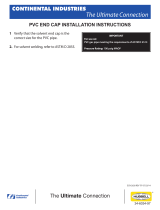DESIGN
DATA
8
Compressed Air & Insert Gas Piping Systems
Thermal Expansion
Duratec composite pipes have a low coefficient of thermal
expansion, similar to copper pipe. It is about 1/10th of the
expansion rate of most plastic pipes. This eliminates the
need to install “offsets” and the concern of pipe abrasion
from movement due to temperature changes. The coefficient
of thermal expansion is 1.3 x 10
-5
in./in./°F. As an example,
100 feet of Duratec pipe with a 10°F rise in temperature will
expand 0.156 inches.
Contaminants
There are four general classes of contamination:
1. Liquids (oil and water)
2. Vapor (oil, water, and hydrocarbons)
3. Gas
4. Particulates
An understanding of the various pollutants in the air is helpful
when an engineer has to decide what equipment is required to
effectively reduce or remove them. The required level of
protection from the various contaminants depends upon the
purpose for the air. Prior to the selection of equipment the
performance criteria for each system, along with the identity
and quantity of pollutants, must be determined.
General Considerations for Piping System Design
A compressed air system must be controlled, regulated, and
sized to ensure that an adequate volume of air, at a specific
pressure and purity, will satisfy user requirements during the
period of heaviest use.
Overview of Design
1. Locate each process, work station, or piece of equipment
that uses compressed air. They should be located on a
plan, and a complete list should be made to simplify
record keeping. This initial process will act as a
beginning for your piping layout.
2. Determine the volume of air and pressure range used at
each location. Information regarding pressure and flow
rates for equipment such as tools can be obtained from
the manufacturer. If the pressure and flow rates are not
known, assign some preliminary rates until the specific
values can be obtained.
3. Determine the system conditioning requirements for each
piece of equipment. This includes the allowable moisture
content, particulate size, and oil content. The system
may require conditioning equipment including dryers,
filters, lubricators and pressure regulators.
4. Establish how much time the individual tool or process
will be in actual use for a one-minute period of time.
This is referred to as the “duty cycle.” In most industrial
applications, tools or operations of a similar nature are
usually grouped together.
5. Establish the maximum number of locations that may
be used simultaneously on each branch, on each main,
and for the project as a whole. This is known as the
“use factor.”
6. Establish the extent of allowable leakage. Leakage is a
result of the number and type of connections, the use
of disconnects, the age of the system and the quality of
the initial assembly process. Many small tools and
operations will result in more leakage than fewer larger
applications. A well maintained compressed air system
will have an allowable leakage rate of 2% to 5%.
Note: This allowable leakage rate applies only to
compressed air made on site. All other inert gas systems
must be designed with the strictest health and safety
considerations in mind including preventing leakage of
any pipe contents.
7. Establish any allowance for future expansion. Thought
should be given to oversizing some components
(i.e., main supply lines) to avoid the cost of replacement
at a later date.
8. Make a preliminary piping layout and assign a preliminary
pressure drop for the system.
9. Select the air compressor type, conditioning equipment,
equipment location, and air inlet, making sure that
scfm (L/min) is used consistently for both the system
and compressor capacity rating.
To start, the following information must be available:
• Total connected flow rate cfm (L/min) of all air-using
devices, including flow to the air dryer system
if applicable.
• Maximum pressure (psi) all air-using devices require.
• Duty cycle and use factors for these devices giving
maximum expected use of air.
• Leakage and future expansion allowance, cfm (L/min).
• Allowable pressure drops for the entire system,
including piping and conditioning equipment.
• Altitude, temperature, and contaminant removal
corrections.
• Location where adequate space is available for air
compressor and all ancillary equipment.
• Produce a final piping layout and size the piping
network.
























